 |
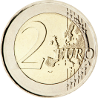 |
C o m m e m o r a t i v e
C o i n s |
||
| Latvia | |||||||
The edge lettering on the Latvian 2‐Euro‐commemorative coins is : (God bless Latvia) |
|||||||
| Image | Country | Feature | Ref. | ||||
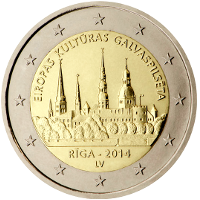
|
 |
Latvia | Riga, European Capital of Culture 2014 | 20001 |  |
||
Volume : 1,005,000 Date of Issue : 12 Aug. 2014 Designer : Henrihs Vorkals Engraver : Jānis Strupulis Producer : German mint Staatliche Münzen Baden‐Württemberg in Stuttgart (without Mintmark) |
|||||||
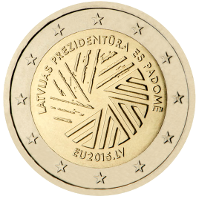
|
 |
Latvia | EU Presidency | 20001 |  |
Volume : 1,025,000 Date of Issue : 10 Feb. 2015 Designer : Gunārs Lūsis Engraver : Jānis Strupulis Producer : German mint Staatliche Münzen Baden‐Württemberg in Stuttgart (without Mintmark) — Proof : deutsche Prägestätte Staatliche Münzen Baden‐Württemberg in Karlsruhe (without Mintmark) |
|||||
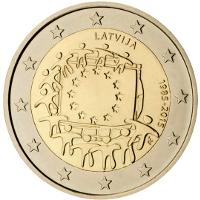
|
 |
Latvia | 30th anniversary of the EU‐Flag | 20001 |  |
Volume : 1,010,000 Date of Issue : 03 Nov. 2015 Designer : Georgios Stamatopoulos ("ΓΣ") Producer : German mint Staatliche Münzen Baden‐Württemberg in Stuttgart (without Mintmark) |
|||||
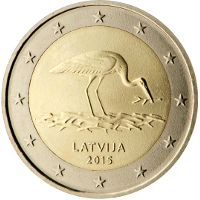
|
 |
Latvia | Stork | 20001 |  |
Volume : 1,000,000 Date of Issue : 01 Dec. 2015 Designer : Olga Šilova Producer : Lithuanian mint Lietuvos monetų kalykla in Vilnius (without Mintmark) |
|||||
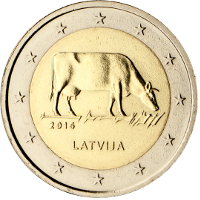
|
 |
Latvia | Latvian agriculture industry | 20001 |  |
Volume : 1,010,000 Date of Issue : 19 Jul. 2016 Designer : Gunārs Lūsis Engraver : Jānis Strupulis Producer : Lithuanian mint Lietuvos monetų kalykla in Vilnius (without Mintmark) |
|||||
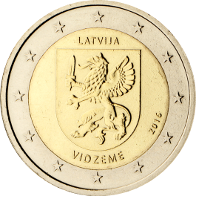
|
 |
Latvia | Vidzeme (Livland) 1st coin of the Historical Regions series |
20001 |  |
Volume : 1,010,000 Date of Issue : 15 Nov. 2016 Designer : Laimonis Šēnbergs Engraver : Jānis Strupulis Producer : Lithuanian mint Lietuvos monetų kalykla in Vilnius (without Mintmark) |
|||||
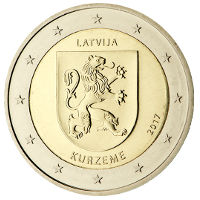
|
 |
Latvia | Kurzeme (Courland) 2nd coin of the Historical Regions series |
20001 |  |
Volume : 500,000 Date of Issue : 14 Nov. 2017 Designer : Laimonis Šēnbergs Engraver : Jānis Strupulis Producer : German mint Staatliche Münzen Baden‐Württemberg in Stuttgart (without Mintmark) |
|||||
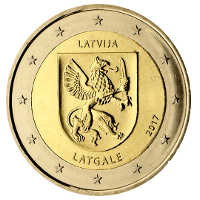
|
 |
Latvia | Latgale 3rd coin of the Historical Regions series |
20001 |  |
Volume : 500,000 Date of Issue : 14 Nov. 2017 Designer : Laimonis Šēnbergs Engraver : Jānis Strupulis Producer : German mint Staatliche Münzen Baden‐Württemberg in Stuttgart (without Mintmark) |
|||||
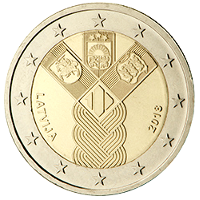
|
 |
Latvia | Establishment of the states of Estonia and Latvia, Re-establishment of the state of Lithuania Common Issue of the three Baltic States |
20001 |  |
Volume : 512,000 Date of Issue : 31 Jan. 2018 Designer : Justas Petrulis Producer : Lithuanian mint Lietuvos monetų kalykla in Vilnius (without Mintmark) |
|||||
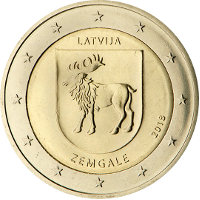
|
 |
Latvia | Zemgale (Semigallia) 4th coin of the Historical Regions series |
20001 |  |
Volume : 507,000 Date of Issue : 26 Sep. 2018 Designer : Laimonis Šēnbergs Engraver : Jānis Strupulis Producer : German mint Staatliche Münzen Baden‐Württemberg in Stuttgart (without Mintmark) |
|||||

|
 |
Latvia | Coat of arms of Latvia's rising sun | 20001 |  |
Volume : 307,000 Date of Issue : 17 Sep. 2019 Designer : Ivars Drulle Producer : Royal dutch mint Koninklijke Nederlandse Munt in Utrecht (without Mintmark) |
|||||
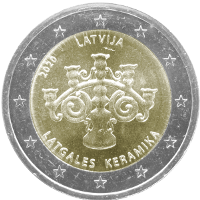
|
 |
Latvia | Letgalian ceramics | 20001 |  |
Volume : 412,000 Date of Issue : 05 Jun. 2020 Designer : Gundega Rancāne Producer : Lithuanian mint Lietuvos monetų kalykla in Vilnius (without Mintmark) |
|||||
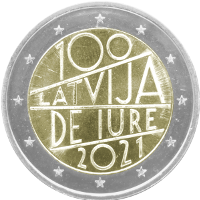
|
 |
Latvia | 100th anniversary of the recognition of the Republic of Latvia | 20001 |  |
Volume : 412,000 Date of Issue : 20 Jan. 2021 Designer : Zane Ernštreite Producer : German mint Staatliche Münzen Baden‐Württemberg in Stuttgart (without Mintmark) |
|||||
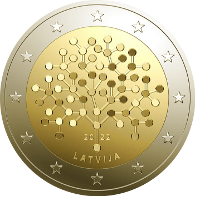
|
 |
Latvia | 100 years of Bank of Latvia | 20001 |  |
Volume : 415,000 Date of Issue : 12 Apr. 2022 Designer : Reinis Pētersons Producer : Lithuanian mint Lietuvos monetų kalykla in Vilnius (without Mintmark) |
|||||
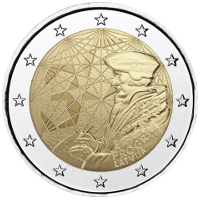
|
 |
Latvia | 35th anniversary of the Erasmus Program | 20001 |  |
Volume : 308,000 Date of Issue : 01 Jul. 2022 Designer : Joaquin Jimenez Producer : Lithuanian mint Lietuvos monetų kalykla in Vilnius (without Mintmark) |
|||||

|
 |
Latvia | The Sunflower of Ukraine | 20001 |  |
Volume : 415,000 Date of Issue : 20 30 May 2023 Designer : Krišs Salmanis Producer : Lithuanian mint Lietuvos monetų kalykla in Vilnius (without Mintmark) |
|||||
| References : | |||
| 20001 | Images taken with authorisation by the ECB ‐ Mail dated 20.Feb.2020 © "European Central Bank" |
20002 | Not Applicable |
| 20003 | Images taken temporally from the Internet | 20004 | Not Applicable |
 |



